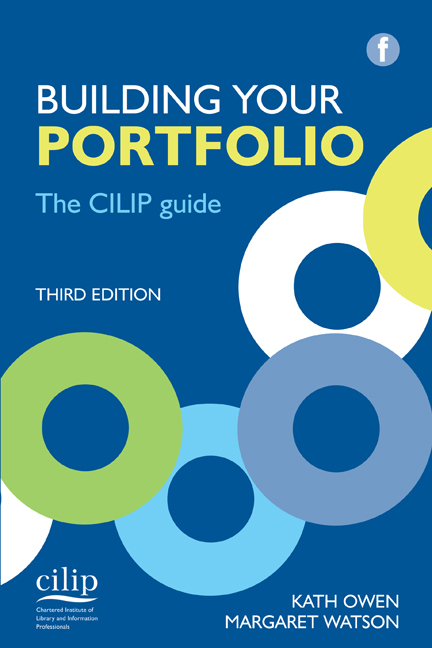Book contents
- Frontmatter
- Contents
- Contributors
- Foreword
- Acknowledgements
- 1 Introduction and getting started
- 2 Assessment criteria
- 3 Working with a mentor
- 4 Reflective writing
- 5 The curriculum vitae
- 6 The Professional Knowledge and Skills Base
- 7 Evaluative statements
- 8 Supporting evidence
- 9 The final steps
- Bibliography and references
- Websites
- Index
2 - Assessment criteria
Published online by Cambridge University Press: 08 June 2018
- Frontmatter
- Contents
- Contributors
- Foreword
- Acknowledgements
- 1 Introduction and getting started
- 2 Assessment criteria
- 3 Working with a mentor
- 4 Reflective writing
- 5 The curriculum vitae
- 6 The Professional Knowledge and Skills Base
- 7 Evaluative statements
- 8 Supporting evidence
- 9 The final steps
- Bibliography and references
- Websites
- Index
Summary
What are assessment criteria?
At its simplest, assessment can be defined as the process whereby evidence of achievement is judged. Each CILIP award recognizes the achievement of the applicant. For professional registration the evidence put forward is the Portfolio. Your Portfolio is assessed by at least two professional colleagues who are members of the Professional Registration and Accreditation Board. It is essential that you become familiar with the particular assessment criteria against which your Portfolio will be judged.
You should keep a copy of the criteria next to your PC or on the desk where you are working on your Portfolio. It is so easy to get carried away by collecting evidence that you can sometimes forget to focus on the criteria. The assessment criteria tell you what you need to demonstrate. Ask yourself frequently whether your Portfolio presents the correct evidence to meet the criteria.
The assessment criteria for each level are discussed in this chapter and broken down to help you ensure that all essential areas are covered. These are followed by reflections on assessment by Keith Wilson. (There are further guidelines for each element of your Portfolio in succeeding chapters.)
Certification (ACLIP)
Identify areas for improvement in personal performance and undertake activities to develop skills and enhance knowledge
Key words and terms:
• identify
• improvement in personal performance
• undertake activities
• develop skills
• enhance knowledge.
Think about your performance at work, what is going well and what you could improve. How can you make improvements, what could you do, on your own or with help from other people?
What sort of activities would help? Possible activities include reading, online or offline, journals or books; watching other people; attending a training event; or just talking to your manager or a colleague.
Your starting point for this is the PKSB (see Chapter 6). This will help you to reflect on your current performance and identify needs for further development. Remember that you will only be working on selected areas that are relevant to your work. An additional aid may be any performance appraisal or development scheme that you already have in your workplace.
- Type
- Chapter
- Information
- Building Your PortfolioThe CILIP guide, pp. 7 - 20Publisher: FacetPrint publication year: 2015



